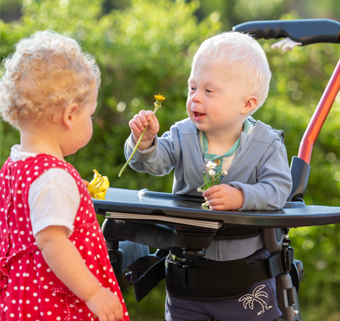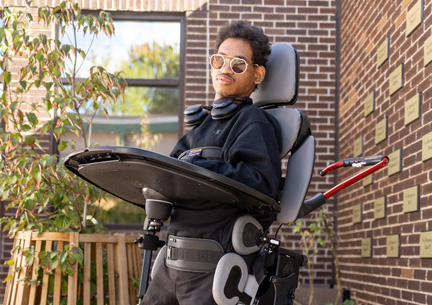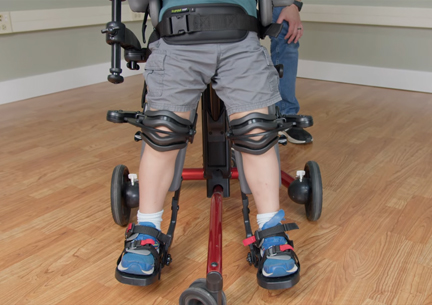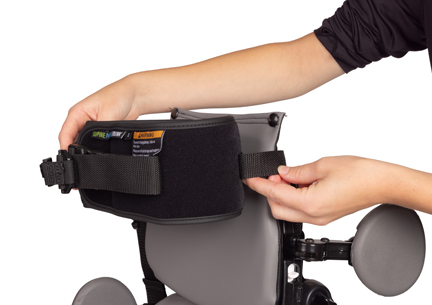Prone Standers: Positioning for Health and Independence
| September 2013 Prolonged immobility in a seated or supine position can result in contractures, skeletal deformity, skin ulcers and decreased bone mineral density. It can cause deficits in the digestive, respiratory, and circulatory systems. This is especially true for children with special needs who have decreased muscle strength, balance and tone issues. Because they cannot move or stand independently, these children will often spend more time in a wheelchair or other static positioning system.
Prolonged immobility in a seated or supine position can result in contractures, skeletal deformity, skin ulcers and decreased bone mineral density. It can cause deficits in the digestive, respiratory, and circulatory systems. This is especially true for children with special needs who have decreased muscle strength, balance and tone issues. Because they cannot move or stand independently, these children will often spend more time in a wheelchair or other static positioning system.
Having the opportunity to bear weight through the lower extremities and extend the joints is crucial to improved health outcomes in this population. Positioning a child with special needs in an upright, standing position is the first step to facilitating bone and muscle development and maintaining range of motion in addition to encouraging better functioning of the body’s internal systems. When I speak to lay audiences I tell about how standing benefits the five B's: bone, breathing, blood, bowel/bladder, and brains.
The earlier you can start the better. Children with disabilities are not born with contractures or skeletal deformities, but these can develop over time as secondary impairments. Starting a standing intervention early will help maintain range of motion of the hips and knees, certainly minimizing the chance of joint contractures, and also facilitating bone growth and timely development.
Over time, with increased standing opportunities provided for the child, upper and lower body strength and balance will improve as well as overall standing tolerance. This prepares the child for transition to less restrictive and more mobile adaptive equipment for active standing and walking. Essentially, that is the goal of adaptive standing intervention – to provide opportunities for weight-bearing that will increase a child’s overall health and lead to further opportunities for independence and mobility.
The Prone Stander
 A prone stander is recommended for children who are able to maintain head control. Prone standers support a child from the front of the body in a forward leaning position. Aside from the weight-bearing and extension of the hips and knees that is occurring, this is a great position for developing neck and upper trunk extensor muscles for postural control.
A prone stander is recommended for children who are able to maintain head control. Prone standers support a child from the front of the body in a forward leaning position. Aside from the weight-bearing and extension of the hips and knees that is occurring, this is a great position for developing neck and upper trunk extensor muscles for postural control.
The Rifton Prone Stander comes in three sizes. The curved S-frame gives plenty of room for the caregiver to stand close to the child. The trunk board can be raised and lowered relative to the footboard for height adjustments so even the smallest child can be positioned. The stander’s accessories and positioning prompts can be quickly adjusted or even removed to support a variety of physical disabilities or to encourage skill-building.
Therapeutic Positioning
To maintain a standing position, knee extension and hip extension are required. Equipment can provide the necessary support and external control to make this possible.
Therapeutic positioning uses adaptive equipment for postural placement of the body with alignment and stabilization. Therapeutic positioning should not be viewed as an end in itself but rather as a means to functional activities.
Give careful thought to which prompts and accessories are needed. Providing too much support for postural positioning can be detrimental since children with special needs tend to “depend” on the support they are given rather than use their own motor skills to participate in the task. Too much external support therefore, can limit the child from developing independence in postural control. On the other hand, insufficient prompting can result in poor alignment and positioning of the body allowing for possible deformity or hampering participation in activity. A good balance needs to be found supporting the child just enough to maintain good alignment, yet not so much as to prevent some independent movement and allow for some challenge to the body’s boundaries of stability.
Positioned this way a child can participate in an activity like accessing classroom materials or writing on the chalkboard. Adaptive standing intervention certainly helps to pave the way for participation but also prepares the child for gait training and mobility – one step closer to independence.




